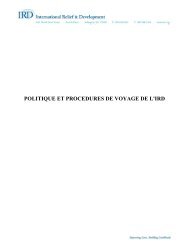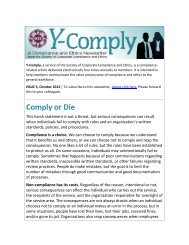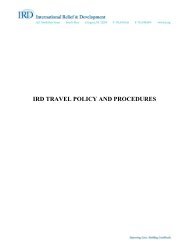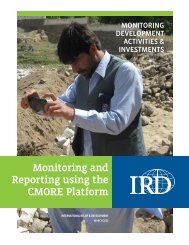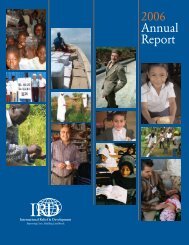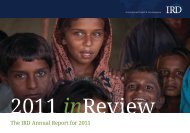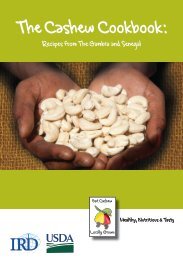Roof-Top Rainwater Harvesting Best Practices Guide - International ...
Roof-Top Rainwater Harvesting Best Practices Guide - International ...
Roof-Top Rainwater Harvesting Best Practices Guide - International ...
Create successful ePaper yourself
Turn your PDF publications into a flip-book with our unique Google optimized e-Paper software.
Figure 5: WASH Manual & Toolkit<br />
IRD Zimbabwe developed the Water Sanitation and Hygiene (WASH) Training Manual and Toolkit for Schools with<br />
roof-top RWH systems as a tool for teachers at schools benefiting from the program to educate their students on<br />
the usage and care of the system, and for improved hygiene practices. Similar training tools can be developed for<br />
other projects.<br />
Available from: www.ird.org/uploads/<strong>Rainwater</strong>_<strong>Harvesting</strong>_-_School_Manual.pdf<br />
Student WASH training at rural schools in Zimbabwe<br />
This engenders a step away from dependency, and<br />
towards empowering the community to manage<br />
the roof-top RWH systems, to form solutions, and<br />
even to improve on certain aspects of roof-top<br />
RWH technologies in their communities. 11<br />
4.5.1. Operation & Maintenance (O&M)<br />
Planning and Training<br />
ɇɇ<br />
Assess beneficiaries’ ability to maintain the<br />
system, and create appropriate training plan<br />
ɇɇ<br />
Set up responsibility structure for the<br />
roof-top RWH systems. This will vary depending<br />
on the beneficiary, i.e., household, community<br />
or institution.<br />
ɇɇ<br />
During planning process set up maintenance<br />
plan and provide appropriate training<br />
ɇɇ<br />
Train someone to undertake routine<br />
maintenance. This should include<br />
management of the day-to-day operation<br />
of the water point, and how to repair any<br />
relatively small problems with the system.<br />
ɇɇ<br />
Communities must follow all technical<br />
recommendations and plan a budget to cover<br />
maintenance.<br />
ɇɇ<br />
It is important to train all beneficiaries on<br />
operation and maintenance, however extracting<br />
water from the system should be limited<br />
to specific individuals who have received<br />
specialized O&M training.<br />
4.5.2. Planned Maintenance and<br />
Management<br />
ɇɇ<br />
Create a plan and schedule for cleaning<br />
roof and tank. The schedule needs to<br />
accommodate rainfall patterns.<br />
ɇɇ<br />
Plan for regular water quality testing, and to<br />
monitor any water loss.<br />
ɇɇ<br />
Create a monitoring sheet to record inputs<br />
and outputs, along with dates.<br />
ɇɇ<br />
Identify the person to be trained to manage the<br />
management system.<br />
4.5.3. WASH Training<br />
Devise appropriate training curriculum or<br />
methods, including developing manuals and<br />
charts to cover materials provided in trainings.<br />
These may differ at various levels as follows:<br />
Household:<br />
ɇɇ<br />
Educate household on water treatment and<br />
testing options, and let households choose the<br />
method they prefer.<br />
ɇɇ<br />
Train on how to manage the resource (this is<br />
important to ensure water availability through<br />
dry spells, and also considering that many<br />
household beneficiaries share water with<br />
neighbours for example).<br />
ɇɇ<br />
There are several household level training<br />
methodologies that can be used in conjunction<br />
18 <strong>Roof</strong>-<strong>Top</strong> <strong>Rainwater</strong> <strong>Harvesting</strong> <strong>Best</strong> <strong>Practices</strong> <strong>Guide</strong>


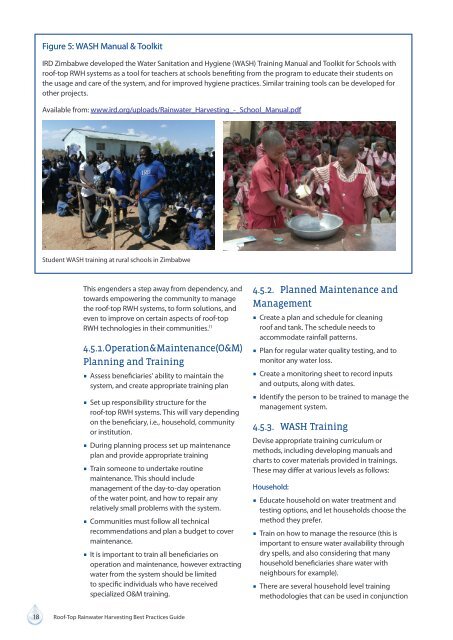
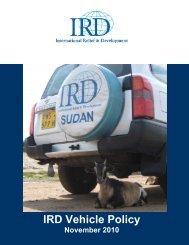
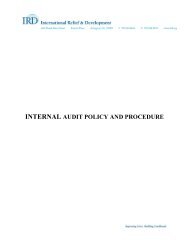
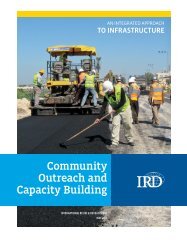
![Guide bonne pratique production d'oignon qualité_VF_4_2411012[1]](https://img.yumpu.com/23506639/1/184x260/guide-bonne-pratique-production-doignon-qualitac-vf-4-24110121.jpg?quality=85)
